As Winter thawed we did much manoeuvring around Maryland but not much became of this, and once Spring arrived we were moved to ports and embarked upon USN transports, destination initially unknown, but later revealed to be the Virginia Peninsula. By late spring we were in Virginia and marching on Richmond confident of victory under our new army commander George B. McClellan. There was minor skirmishing with the Rebels and some brisk actions, but we always stood firm and soon were continuing our irresistible movement North, my brigade was not significantly involved in these actions. we did learn from intelligence gathered that our opponents from last year, Longman’s Brigade, were part of the forces defending Richmond and we may well get a second chance to try conclusions with them… And it was at a place we dubbed Seven Pines that the Confederate’s did launch a surprise counter attack on our forces and this is where I shall take up my story…
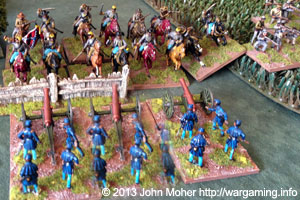
I have previously written about our Winter activities and explained the current state of my Brigade which is how we entered the Spring of 1862, and it was as described there that we commenced this battle in our ‘Peninsula’ campaign. After a few weeks of intermittent marching and slow advances we were temporarily attached to General Keyes IV Corps and were holding a small part of the defence line observing the Confederates about 5 miles before Richmond, when on our second day in that position the rebels swooped down on us in force, initiating a major engagement, at Seven Pines – and our position was not too distant from the Fair Oaks Station on the railroad. It was 31 May, in the Summer of 1862.
I had deployed my brigade based around a dependable small farm, which had some sturdy fencing along it’s fields, and a small wood on the West side, and a low rise to the South-East – an ideal spot as I had observed to place some of my artillery. My deployment saw the 1st Massachusetts, and Company G, 1st US Artillery deployed directly in the fields of crops defending the fence line, the 1st MA had (as previously mentioned) been assigned our brigade’s company of Sharpshooters, and these were deployed forward in the small wood in front of the walls. G/1 US had their 6pdrs & Howitzer sections deployed on the right of the line, covering the open area North of the small wood, in front of the larger areas of fields further North (note that shortly before our artillery companies had been officially designated batteries, but I have continued to use our old terminology here). I then deployed my new battery Company M, 2nd US Artillery (who were originally destined for the Horse Artillery Brigade) on the high ground left (South-East) of the 1st MA, their 3 sections’ magnificent new 3-inch Rifles ideally placed here to bombard any approaching enemy.
The newly arrived Regiments were assigned to the rear of each flank, their battle stations being to move up and extend the line either side to complete our battle line in the event of an enemy attack. 69th New York was on the left (South) and 3rd Michigan the right (North). The now veteran but significantly diminished 12th New York was in direct support behind the central position and my main reserve was the 5th US Cavalry (sans horses) who were serving as surrogate-infantry for this action… My last Regiment, the 2nd Michigan, were currently detached to our rear performing quartermaster tasks and assisting the pioneers – they would be called forward if action developed but would take a little time to arrive on the field.
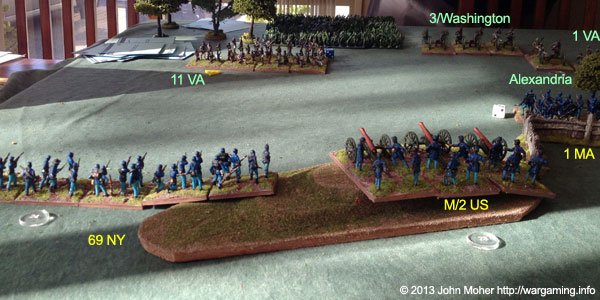
And so we were when the first signs of an impending attack occurred in the distance we heard the booming of cannon and the rattle of musketry, gradually getting closer, and it was not long before we soon saw enemy approaching our position. The enemy was quickly upon us and seemed determined to force a quick result – it was not long before we recognised their standards, and the “Lynchburg Cougars” (who we had learned had been retitled the 2nd Virginia Volunteer Cavalry), and knew as fate would have it we were facing our old adversaries again… The advanced rapidly on our centre and right, with a regiment of infantry at each and the “Cougars” riding in between – to the rear they appeared to have near as many guns as us (5 sections), all on the move to some as yet unclear destination. A third infantry regiment covered our left but did not directly advance initially…
While Company M, 2nd US bean bombarding the limbered enemy artillery, I immediately ordered our men forward after some preliminary skirmishing in both the centre and the right, to force conclusions as early as possible with the enemy, and to do so within the woodland and fields of tall crops to minimise the risk of the cavalry joining in. As we may have a temporary numerical superiority it was vital to use our numbers as effectively as possible… Meanwhile the 12th New York and 5th US Cavalry began moving up to support the front line troops, and I had dispatched a request to Colonel Poe of the 2nd Michigan to collect his men and hurry to the field at his earliest convenience.
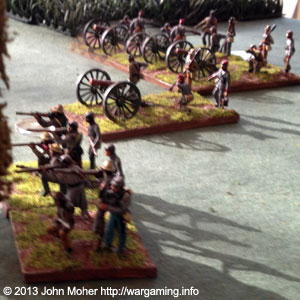
Our charges with bayonet were partially successful, in the centre the 1st Massachusetts clashed with the 1st Virginia Volunteer infantry, and threw them back from the wood in disorder and with many casualties (I don’t think they ever really recovered from this magnificent first onslaught of the “Mighty Massachusetts”), their numbers considerably reduced. On the right the 3rd Michigan were less successful, being thrown back by the experienced 17th Virginians. However there was excellent work done by M/2 US with their Parrot Rifles under Captain Benson of New Jersey, both the enemy batteries, and the Alexandria Artillery (of Virginia) taking heavy damage and losing a section of guns. Of note to readers may be that the Washington Artillery had 2 x 6pdr and 1 x howitzer sections, while the Alexandria Artillery had 1 x Napoleon and 1 x Rifle sections, and our initial bombardment destroyed the latter’s Rifle section. (Initial casualties favoured the US at this time 1 to 4).
However Colonel Longman soon got his revenge, the 2nd Virginia Cavalry (the “Lynchburg Cougars“) shortly after charged the G/1 U.S. Artillery battery, and with deep regret I must report overran the battery and effectively destroyed it – there were many casualties and the few survivors were dispersed and after the battle when they reassembled the battery was temporarily disbanded and the men assigned to other batteries as replacements. Around the time of the “Cougar’s” charge the artillery began deploying into firing positions, and on our left the 11th Virginia finally began to advance…
With the demise of my 1st US artillery it was necessary to send the 12th New York forward to fill the gap in our lines. On the right the 3rd Michigan continued to work hard on holding back the experienced 17th Virginians’ and in the centre the “Mighty” 1st Massachusetts continued to have it over the 1st Virginians and their supporting artillery… On the left the Coy M, 2nd US Artillery switched targets, targeting the 11tn Virginia, who had advanced from their cover against the 69th New York on my left – the artillery’s bombardment was most effective inflicting heavy casualties on the Virginians. The Rebels soon counter-attacked in the centre and against our right, the 1st Virginia charged the “Mighty Massachusetts“, while the “Lynchburg Cougars” (2nd VA Cav) did likewise to the Veteran 12th New Yorkers. The cavalry’s charge was somewhat disrupted however by some unseen rough ground, however the still closed with the New Yorkers. Both of our Regiments were (temporarily) thrown back with casualties by this attack, the Mighty Massachusetts boys retiring back across the fence line into the crops fields, while the 12th New York pulled back to cover the 3rd Michigan’s flank, who had taken some casualties from enemy musketry, but had returned the favour. (Casualties still favoured the US at 6 to 10).
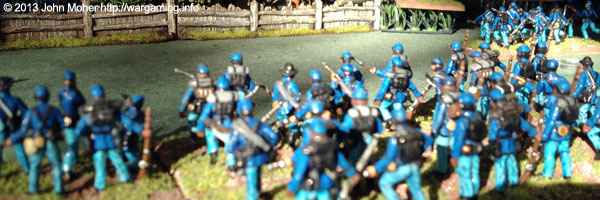
We quickly counter-attacked, and my Mighty Massachusetts‘ advanced back over the fence-line into the woods to take on the 1st Virginian’s once more; and the 3rd Michigan and 12th New York edged forward against the 17th Virginia Regiment. On my left I held the 69th New York back, being fairly inexperienced I did not want them being overwhelmed by their more numerous and experienced foes, the 11th Virginia. In the centre an heroic bayonet charge by the Massachusetts’ threw the 1st Virginians back yet again in considerable disorder and with heavy casualties – this Regiment was proving the absolute hero of the battle for our forces! The rebel response was subdued and our follow up was another telling bombardment from the 2nd US Artillery against the 11th Virginians, and a combined charge by the 12th New York and 3rd Michigan against the 17th Virginians’ on our left… While our bombardment were very successful our charge was thrown back with heavy casualties, the 12th New York breaking and dispersing. (Casualties favoured the US still but were now 9 to 12).
Again the Confederate response was subdued – and again we responded with the Mighty Massachusetts charging – this time the combined Confederate Batteries (Coy 3, Washington Artillery and the Alexandria Artillery). In a glorious effort, and despite some previously unseen broken ground in front of the guns, the 1st Massachusetts Infantry overrun the entire rebel artillery park, breaking and dispersing both batteries, and capturing all 8 guns (1 x Napoleon, 2 x 6pdr, and 1 x Howitzer Sections)! It was indeed a day the Regiment would earn a great battle honour! Following this magnificent effort (and as casualties were now favouring the US 9 to 16) the rebel effort was spent, the loss of all their artillery proving too much, and Colonel Longman’s Brigade began it’s retirement, defeated but not broken – but still we had got our revenge for our previous encounter!
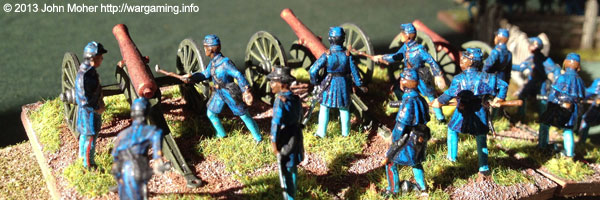
Just as the battle was ending, my 2nd Michigan Infantry appeared hurrying forward to support us, but too late to participate in the action. We had taken casualties, but I was very happy and impressed with my men – they had done me proud! The unfortunate G/1st US Artillery had had too many casualties to be reformed, so the unit was temporarily disbanded and the survivors despatched to other artillery units as replacements. As for the 12th New York, even as I write this my brigade staff are endeavouring to see what of the regiment survives and rally those survivors back to the colours. As we mustered after the battle we numbered:
- 1st “Mighty” Massachusetts Infantry Regiment (Strength 5; Sharpshooters; Hero)
- 2nd Michigan Infantry Regiment (Strength 8) – not engaged
- 3rd Michigan Infantry Regiment (Strength 7)
- 12th New York Infantry Regiment – dispersed, attempting to reform
- 69th New York Infantry Regiment (Strength 6)
- 5th US Cavalry Regiment (Strength 7)
- Company G, 1st US Artillery – overrun & destroyed, disbanded
- Company M, 2nd US Artillery (3 x Rifles)
- Victory Points Earned: 4
Colonel A.P.S. Longman’s Brigade was believed to now be:
- 1st Virginia Volunteer Infantry Regiment (Strength 2)
- 11th Virginia Volunteer Infantry Regiment (Strength 5; Hero)
- 17th Virginia Volunteer Infantry Regiment (Strength 8; Sharpshooters)
- 2nd Virginia “Lynchburg Cougars” Cavalry Regiment (Strength 7)
- 3rd Company, “Washington Artillery” – overrun & destroyed
- “Alexandria Artillery” – overrun & destroyed
- Victory Points Earned: 4
Following on from this action an even greater one occurred a few weeks later, dubbed the “Seven Days” – we were not heavily engaged and although the action was not decisive for our forces we were still confident of reaching Richmond. However shortly after we were rapidly withdrawn and re-embarked, sailing back to Maryland whence we had come just 3 months prior…
The Battle In Photos
About the Figures
The figures, for those interested, are all 1/72nd scale plastics from Cam’s collection – they are a mixture of mostly Italeri & IMEX, with assorted Revell, HäT, & Accurate mixed in. The only notable brand not present are the venerable Airfix chaps; as Cam stays well clear of the only other choice, Strelets, due to the poor quality…














It appeared Longman was out numbered in this round, did the quality help them? And I suspect its going to get worse for the next round.
Game looks interesting, thou not knowing how the combat mech work hard to draw to many conclusions, but it looks like it could be a winner.
How long did the game take to play out?
looking forward to the next one 🙂
cheers
Hi Scruff – Yes Numbers favoured the USA, however 1 x Strength 8 US Infantry was never involved so in reality USA only had 1 Inf Stand & 1 Arty Stand more than the CSA on table (you can easily count that up in the photos) – and the CSA units were better quality. So Longman wasn’t heavily outnumbered. However the deployment meant Rickards (Me) was in a position to be fairly aggressive if desired, and had some very deadly shooting from his artillery! The 1st Massachusetts were true heroes too, getting some impressive combat results.
Longman probably didn’t help himself (in general terms) by having his force a bit uncoordinated – in the end the 11th Virginia (on the CSA left) did nothing but mill around and be artillery targets for the 2nd US’s 3″ Rifles – and they were good quality troops representing over 1/3 of his Infantry force! 🙂
I hope to post the campaign activity up in the next few days so you will be able to see the campaign’s continuing progression soon.
Regardign time, we played both the initial Marching On Richmond Game and this game (and the campaign activity for both) on the same day in about 6 hours – and we weren’t especially fast. 🙂